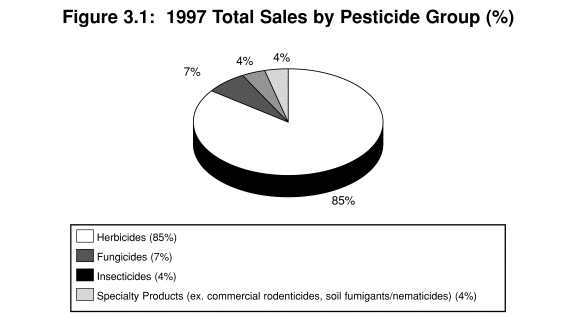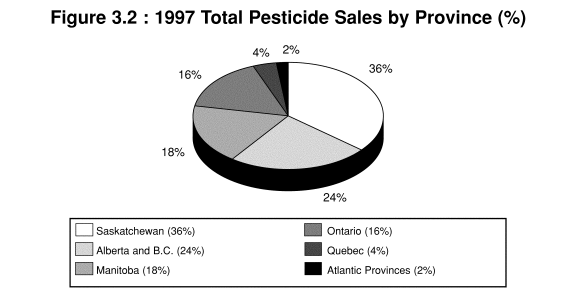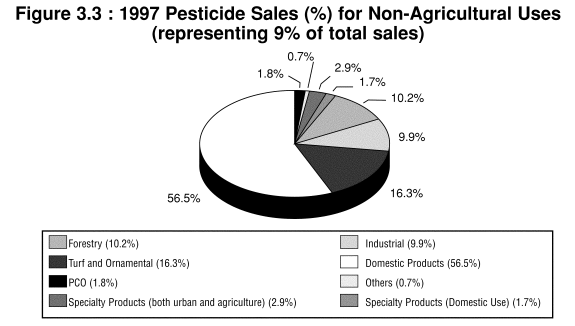ENVI Committee Report
If you have any questions or comments regarding the accessibility of this publication, please contact us at accessible@parl.gc.ca.
3. HISTORY OF PESTICIDE USE
The Main Classes of Chemical Pesticides
3.1 There is information to suggest that certain types of pest control products were used in Roman times, but the use of synthetics began in the 1930s and became more widespread after the end of World War II. Today, there are many categories of chemical pesticides being used in Canada, of which five principal classes are discussed in this chapter. Those in the organochlorines group were first used in the 1940s. From about 1945 to 1965, organochlorines were used extensively in all aspects of agriculture and forestry, in protecting wooden buildings and protecting humans from a wide variety of insect pests.
3.2 The discovery of a second more powerful group of insecticides, the organophosphates, led to the replacement of organochlorines and, in fact, many organchlorines are now banned in Canada16. Certain organophosphates are systemic: unlike non-systemic pesticides, they are taken up by the plant's tissues and the plant then inhibits or kills the bacteria, fungi or parasites.17
What are pest control products? A pest control product is a product intended to control, destroy, attract or repel any pest, and includes chemicals, devices (such as pheromone traps) and even organisms (such as bacteria) (definitions from the Pest Control Products Act). The word pesticide is more specific and includes herbicides, insecticides and fungicides, as well as algicides, insect and animal repellents, antimicrobial and cleaning products, wood and material preservatives, and insect and rodent traps. Most pesticides are intentionally toxic to the target organisms. Pesticides are comprised of the "active" ingredients (the part with the pesticidal effect) and other ingredients such as surfactants, adjuvants, etc. used to augment the effects of the active ingredient. These, too, can be harmful to human health or the environment. (1999 Report of the Commissioner of the Environment and Sustainable Development, Exhibit 3.4). |
3.3 Carbamate insecticides came into use later than both the organochlorines and the organophosphates and are less widely used than the others. Their use is diverse; some are used extensively for forest protection, while others are widely used against insect pests of potatoes and grains. The synthetic pyrethroid group of insecticides was introduced more recently, in the early 1970s, although natural source pyrethrum has been used for hundreds of years. Synthetic pyrethroids are more stable to light and possess a higher insecticidal activity, almost ten times that of most organophosphates and carbamate insecticides. The stability and activity of the synthetic pyrethroids are reflected in their increased use during the last two decades on fruits, vegetables and corn. The high insecticidal activities of these chemicals allow relatively small amounts to be applied (about 100 grams/hectare).18
3.4 Although most of the groups mentioned above are insecticides, two of the best-known pesticides, 2,4-D and 2,4,5-T, are phenoxy herbicides. In fact, 2,4-D was the first successful semi-selective herbicide to be developed. After 50 years of use, products containing 2,4-D still account for one-quarter of all pesticides used in Canada.19 Fungicides are also used in Canada, and account for about 60% of total agricultural pesticide use in the Atlantic region.20 In addition to the main chemical groups dealt with above, there are many other pesticides on the market, such as aldehydes, amides, pyridil, isoxazol and others, which are not discussed in this report.
3.5 There are more than 7,000 pesticides registered in Canada.21 According to information from the Crop Protection Institute of Canada provided to the Committee by the Urban Pest Management Council of Canada, industry sales for 1997 totalled $1,429,887,000; herbicides alone account for 85% of the market (Figure 3.1). There are no data on total product sales in Canada, as there is no national database of pesticide sales. Still, the data compiled by the Crop Protection Institute following a survey of its members paints an overall picture of the pesticide market based on sales. Figure 3.2 shows a breakdown of total sales (agricultural and non-agricultural) of pesticides by province. The highest sales were in Saskatchewan (36%), Alberta and British Columbia combined (24%), Manitoba (18%) and Ontario (16%) (Figure 3.2).
Source : Crop Protection Institute. 1998 Sales Survey Pest Control Product in Canada, Report and Discussion, Web site, February 2000.
Note : The 1998 Survey included members only. Data are not directly comparable to previous years for all categories.
Source : Crop Protection Institute. 1998 Sales Survey Pest Control Product in Canada, Report and Discussion, Web site Internet, February 2000.
Note : The 1998 Survey included members only. Data are not directly comparable to previous years for all categories.
Most pesticides are used for agricultural purposes (agriculture accounts for 91% of sales), while non-agricultural pest management products represent 9% of sales. In the non-agricultural sector, sales of pesticides for domestic use represent a surprisingly high proportion of profits at 56%, while the forestry and industrial sectors each had sales accounting for about 10% of the market (Figure 3.3).22
At one time, pesticides were used almost exclusively for agricultural purposes, but these data suggest that people now consider that pesticides are essential for beautifying the landscape. Urban-dwellers and golf course managers use considerable amounts of pesticides (Appendix 3.1). Sales of non-agricultural pest management products totalled $121 million in 1997.
General Characteristics of Pesticides
3.6 Over and above the fact that pesticides
are manufactured and intended to be toxic, each pesticide has different chemical and
physical characteristics; biological and physical factors influencing toxicity are too
numerous to warrant meaningful conclusions in any but the most general terms. Criteria
such as toxicity, solubility, degradation, volatility, biotransformation or accumulation
vary from one pesticide to the next. Appendix 3.2 describes these characteristics in terms
of five of the chemical pesticide categories mentioned above. Pesticide transport in the
environment is dealt with in the following chapter, while the toxic effects of pesticides
are examined in Chapters 5, 6
and 7.
Appendix 3.1: Pesticides and Golf Courses
There are two approaches to pesticide use on golf courses, preventative and curative applications with curative being the most common approach. Pesticides that are used on golf courses fall into three categories: insecticides, herbicides and fungicides. Insecticides are used to a lesser extent than either herbicides or fungicides. Herbicides, if used for two to three consecutive years, can pretty well eliminate most weeds of concern. Fungicides are used because fungal pathogens can cause severe loss of grass on a golf course.
It should be noted that present day golf course managers are licensed pesticide applicators and are often university /college graduates.23
Most commonly used active ingredients (products) within each category of pesticide:
Insecticides: diazinon, chlorpyrifos and carbaryl
Herbicides: 2,4-D (mixtures such as Killex); mecoprop, and dicamba
Fungicides: quintozene; iprodione (Rovral); and chlorothalonil (Daconil)24
Appendix 3.2: Description of Major Groups of Chemical Pesticides
| Class of Chemical Pesticides | First Used | Examples | Types | Current Status | Effects |
| Organochlorines | 1942 | aldrin; chlordane; dieldrin; endrin; heptachlor; lindane; methoxychlor; toxaphene; hexachlorobenzene (HCB); pentachlorophenol (PCP); DDT | insecticide, acaricide, HCB & PCP are fungicides | Lindane, methoxychlor and pentachlorophenol are registered in Canada. The other products have been discontinued in Canada, but they are still used in developing nations | Persistent, bioaccumulative, affect the ability to reproduce, develop, and to withstand environmental stress by depressing the nervous, endocrine and immune systems |
| Organophosphates | Very early 1940s | schradan; parathion; malathion | insecticide, acaricide | Schradan was discontinued in 1964 and resulted in a move toward less toxic groups (e.g. malathion, parathion) | Non-persistent, systemic (cholinesterase-inhibiting), not very selective, toxic to human |
| Carbamates | First appeared in 1930 but large-scale use in mid-1950s | carbaryl; methomyl; propoxur; aldicarb | fungicide, insecticide, acaricide | Aldicarb was discontinued in 1964; the others are
registered in Canada Although carbamates share a mode of action with the organophosphates, their effects are reversible and they are biotransformed in-vivo |
Non-persistent, cholinesterase-inhibiting, not very selective, toxic to birds and fish |
| Phenoxy | Large-scale marketing and distribution began in 1946 | 2,4-D 2,4,5-T |
herbicide | 2,4-D is widely used 2,4,5-T banned in Canada |
Selective effects on humans and mammals are not well
known 2,4-D: potential to cause cancer in laboratory
animals 2,4,5-T: is the source of a toxic contaminant dioxin |
| Pyrethroids | 1980 | fenpropanthrin; deltamethrin; cypermethrin | insecticide | Fenpropanthrin is not registered in Canada, unlike the two other pesticides | Target-specific: more selective than the organophosphates or carbamates, generally not acutely toxic to birds or mammals but particularly toxic to aquatic species |
A compilation of data from : Amdur, M.O., Doull, J. and C.D. Klaassen, Casarett and Doull's Toxicology: The Basic Science of Poisons, Fourth Edition, Pergamon Press, 1991; Encyclopedia Britannica, Web Site, "History of Agriculture," November 1999; Environment Canada, Web Site, "Waiting for the Fiddler, Pesticides and the Environment in the Atlantic Region," November 1999; Environment Canada, Web Site, "Pesticides and Wild Birds," Canadian Wildlife Service, Web Site, Hinterland Who's Who, November 1999; U.S. Geological Survey, Web Site, November 1999; Pest Management Regulatory Agency, pers. com., Jan. and Feb. 2000. |
16 Environment Canada, Web site, "Waiting for the Fiddler, Pesticides and the Environment in the Atlantic Region," November 25, 1999.
17 Encyclopedia Britannica, Web site, "History of Agriculture," November 15, 1999.
18 US Geological Survey, Web site, November 1999.
19 Environment Canada, Web site, "Waiting for the Fiddler, Pesticides and the Environment in the Atlantic Region," November, 1999.
20 Environment Canada, Web site, "Waiting for the Fiddler, Pesticides and the Environment in the Atlantic Region," November, 1999.
21 World Wildlife Fund, The Problem with Pesticides in Canada: A Briefing Book for Parliamentarians, April 1999.
22 Urban Pest Management Council of Canada, Brief to the Committee.
23 Doug Rothwell, Compliance and Regional Operations Subdivision, Pest Management Regulatory Agency, pers. comm., January 2000.
24 Pam Charbonneau, Turfgrass Specialist, Ontario Ministry of Agriculture, Food and Rural Affairs, pers. comm., January 2000.


